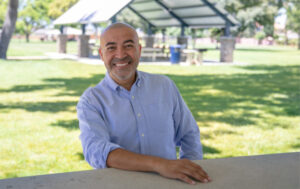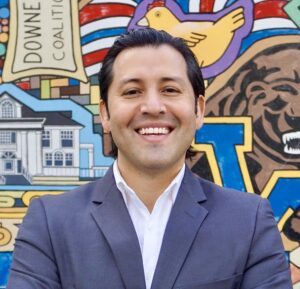Joe Brizzolara
Elected officials from Southeast Los Angeles (SELA) gathered in Long Beach weeks before election day to rally for Measure G, an initiative on the November ballot that has been called “the most significant reform of LA county government in its history.”
The measure would amend the Los Angeles County Charter to add four new supervisorial seats and an elected countywide executive.
Among those who gathered at the Long Beach Convention Center on Oct. 17 were County Supervisor Janice Hahn and representatives from Downey, Bell Gardens, and Lynwood. SELA officials argued that the measure would significantly improve representation of the sub-region at the county level.
If passed, Measure G would make four key changes to county government: establish an elected county executive, expand the Board of Supervisors from five to nine members, introduce open public budget hearings, and create an independent ethics commission.
“LA County’s charter was created in 1912 before women had the right to vote, and when our population was just 500,000,” Hahn, who represents LA County District 4, said. “A lot has changed. LA County is now the largest county in the nation, with 10 million people, more populous than 40 states, home to one out of every 34 Americans. Yet, LA County has a smaller governing body than counties even half our size.”
“My colleagues on the Board of Supervisors and I each represent 2 million people. I alone represent 32 cities and over 150 council members,” she said. “These districts have been too big for too long.”
District 4 stretches from San Pedro to Whittier and encompasses SELA.
Hahn touted Measure G’s potential for improving representation and transparency across the county, particularly for historically underserved communities.
“Measure G will bring real change and ensure that communities that have long been overlooked have a stronger voice at the table,” Hahn said.
Hahn’s support was seconded by Downey Mayor Mario Trujillo, who also sees Measure G as a critical step toward empowering SELA communities.
“For far too long, our communities have been underrepresented in county decisions,” Trujillo said. “Measure G ensures that our voices are heard, that we get the resources we need, and that we have a seat at the decision-making table.”
The most contentious of the proposed changes is the creation of a countywide elected executive—a position, given the size of LA County, that would be akin to the governor of a mid-sized state or the mayor of a city larger than New York City.
Proponents say the office would improve accountability, while opponents, including County Supervisors Holly Mitchell (District 2-South Los Angeles) and Kathryn Barger (District 5-Antelope Valley), argue it would consolidate too much power in a single individual.
A supervisor of one’s own
Bell Gardens Mayor Gabi Gomez says smaller supervisorial districts would mean increased representation on the board for heavily immigrant, working-class SELA cities, like hers.
“We have unique needs in the Southeast, and while Janice Hahn has been very active in engaging with us since taking over our area, she also has to focus on places like San Pedro, which has its own distinct needs. Each section of the district needs its own representation to focus on its particular challenges,” Gomez said.
Bell Gardens is a small, dense city of just 2.5 square miles with a population of roughly 40,000. Nearly 24% of residents live at or below the poverty line, and 41% are foreign-born. Neighboring cities like Bell, Cudahy, and Maywood are similarly sized and with similar demographics. With historically low voter participation, more affluent neighboring cities tend to dominate the votes for shared seats in state and county elections.
In the most recent supervisorial election held earlier this year, only 12% of registered voters in Bell Gardens turned out. Compare that with Long Beach, also in District 4, where 29% of registered voters casted ballots.
Gomez pointed to several pressing challenges in the area, including infrastructure needs related to the upcoming Metro Southeast Gateway Line and housing affordability.
“For Bell Gardens residents, this means a lot. We’re on the opposite side of the freeway from where the Metro line is coming, so we need support for transportation infrastructure to safely get people across. We also need more affordable housing and creative solutions for temporary or transitional housing,” Gomez said. “We need a lot.”
Bell Gardens Councilmember Jorgel Chavez also called for more SELA representation on the Board of Supervisors.
“Just like my brothers and sisters in the San Gabriel Valley want an (Asian American and Pacific Islander) member on the Board, we need someone from Southeast LA,” Chavez said.
Lynwood Councilmember Juan Muñoz-Guevara argued that increased representation on the Board of Supervisors is crucial for contract cities—cities that rely on the county to provide essential services—like his. Contract cities account for half of the cities in LA County, several of which are in SELA.
“Our city contracts with the county for sheriff and fire services. We have a large county facility in our city with many workers, and we want to ensure all communities have a voice and that decisions are informed by the people affected by them,” Muñoz-Guevara said.
Other endorsements from SELA elected officials include Cudahy Vice Mayor Elizabeth Alcantar, Huntington Park Vice Mayor Arturo Flores, Bell City Councilmember Ali Saleh, and Pico Rivera Councilmember Gustavo Camacho.
“The most significant reform of LA county government in its history.”
Hahn’s father, Kenneth Hahn, is a legend in LA politics, serving for 45 years—first as an LA city councilmember (1947–1953) and then as a county supervisor (1952–1992).
“Even back in 1972, when our population was much smaller, my dad… thought that five supervisors were too few,” Hahn said. “He tried and unfortunately failed to expand the board. There was resistance from the Board of Supervisors and from voters.”
Raphael Sonenshein is executive director of the Haynes Foundation—which supports research on governance and democracy in greater Los Angeles—and former executive director of a charter reform commission that successfully introduced significant reforms to L.A. city government approved by voters in 1999. He recalls “numerous” attempts to expand the board.
In a recent article, Sonenshein noted that 50 years ago, the Haynes Foundation funded the Public Commission on Los Angeles County Government, a panel of community leaders and experts. Its 1976 report, “To Serve Seven Million”, recommended creating an elected executive and expanding the board, though voters ultimately rejected these measures twice amid the anti-government sentiment of the late 1970’s.
But the politics of LA County government have changed a lot since then, Sonenshein says, as evidenced by an all-woman board.
“There were numerous women on the Los Angeles City Council, long before there was a single woman on the County Board of Supervisors,” Sonenshein said in a phone interview. “This was forever an incredibly male dominated county government.”
Once known as the “five little kings” of LA County, the board has come to be known as the “five little queens.” Regardless of moniker, these officials hold immense power over a vast social services network, 117,000 employees, and billions in funds from the state and federal government that they partially redistribute downstream to cities. Sonenshein says that the power of individual supervisors is in part due to their dual executive and legislative authority.
“They just have so much power,” he said. “If you’re both legislative and executive, you pass ordinances that affect everyone and also oversee county departments. So, if I’m the (department head), I’m constantly looking over my shoulder at one or more supervisors.”
“Supervisors often get assigned to departments, but it’s a muddled system with no clear executive authority. Do you report to all five supervisors or just the one most interested in your department? City governments usually ensure the legislative body doesn’t interfere too much in departmental operations, but that line is completely blurred in the county system,” he said.
“I think it would probably be the most significant reform of LA county government in its history,” Sonnenshein said.
While he declined to speculate on potential candidates for the seat in 2028, Sonenshein said the eventual countywide executive would “become one of the most important offices in California” if Measure G passes.
The first elections in the new districts would take place in 2032, following the 2030 census.
Not everyone is on board
Supervisors Barger and Mitchell have voiced opposition to Measure G, particularly over concerns that the creation of an elected county executive could consolidate too much power in a single individual.
“I brought forward a motion a year ago, February 2023, to study overall governance updates for the county as a whole, to expand the board… I think that’s a great idea,” Mitchell told NBC LA in a joint interview with Barger. “The challenge with this measure is it does much more, which is the countywide election of a chief executive officer, who has no term limits, who has hiring and firing and oversight authority over all of the department heads, who has full control over the budget with veto power over the board.”
“(This office) completely alters the balance of power between either five, or nine, or whatever number of board of supervisors, and this singular person who’d be responsible for all 10 million Angelenos,” she said.
Barger echoed these concerns.
“Anyone that is saying that this (measure) is going to give better representation throughout the county is being disingenuous,” Barger said. “This is actually consolidating power to one individual that will oversee, not only a $49 billion budget, but 10 million people. So it, in fact, is diluting the power of the board and giving it all to an elected CEO, something that’s buried.”
Barger also believes that a countywide election could dilute the influence of smaller, less populous cities like Lancaster and Palmdale.
Zahra Hajee, campaign spokesperson for the Yes on G campaign, refutes claims that an elected executive would consolidate power, citing safeguards to prevent unchecked authority.
“It’s misinformation to say this consolidates power and turns this position into an all-powerful CEO,” Hajee said. “The measure explicitly states that if the elected executive chooses to hire a department head, it must be confirmed by the board. If the elected executive chooses to veto legislation, the board can override that veto. The elected executive proposes a budget that must be approved, by the board.”
“LA County is the size of multiple states,” she said. “Have we ever seen a state legislature without a governor? No. It’s a check and balance where you have an executive branch with executive authority and a legislative branch with legislative authority.”
Hajee says that the county’s current structure has led to inefficiencies in addressing complex issues like housing, homelessness, and criminal justice reform, despite a massive budget and five supervisors who generally agree with each other.
“This raises the question of where the issue lies,” she said. “A lot of it is structural.”
“An elected county executive position that’s directly accountable to voters would force decision-making to happen in the public arena,” Hajee said.
Both Mitchell and Barger had supported earlier proposals to expand the board, but criticized the current measure as being rushed. Both ultimately abstained from voting to send the measure to the voters earlier this year.
“I’m not sure how this motion settled on nine, given that we have not yet had the opportunity to receive a data-informed recommendation on the number of representatives for our population of over 10 million,” Mitchell said leading up to the Measure G vote on July 9.
Barger also criticized a lack of transparency during the drafting of Measure G.
“(My concern was that) this was done in a way that we had buy-in from all 5 supervisors to bring forward a comprehensive review… so that when we make decisions, they’re made transparently and with input from experts who know what we need to do to get it right,” Barger said at the same meeting. “This was not done in this case.”
Along with more supervisors and an elected countywide executive, Measure G would implement open public budget hearings, allowing the public to have a direct say in LA County’s budget process. Currently, most budget drafting happens behind closed doors, but the measure would require each department to present its proposed budget annually.
It also creates an independent ethics commission whose powers will include the ability to “investigate allegations of misconduct by County officials” and recommend updates to the County Code regarding governmental ethics.







